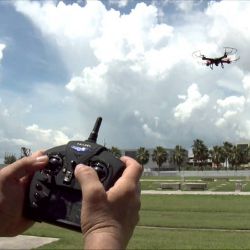
It was not always easy for Jonathan Evans to discuss his "life’s work" as the CEO and co-founder of Skyward, a company that makes management software for drones. "Three years ago, the dinner party conversation went, ‘Oh, you’re in drones? You mean you make weapons?’," he said. "We didn’t and don’t, but back then it was all people knew about them. Now, the public sees drones as a hugely important technology, on the order of the Internet."
In recent years drones, more properly called unpiloted aircraft systems, have gone from expensive, secretive military technology to multipurpose business tools available to anyone with a few hundred dollars. They commonly are used by public utilities to monitor transmission lines; by construction and real estate firms to plan and map developments; by police and fire departments for disaster-relief operations, and by agriculturalists to monitor and improve crops.
Yet recognizing the power of drones for commercial applications is not easy: the technology can be difficult, and small errors can doom an expensive piece of electronics.
Enter a new category of companies that will take care of planning, compliance, and execution of drone flights to customers on an outsourced basis, delivering digital files and intelligence in a variety of formats.
One of the most visible players in this segment at present is Measure, which holds a trademark on the phrase "drone as a service" and which intends to offer coverage in the United States through a franchise system. Other companies connect customers with pilots, with varying amounts of vetting; these include Fly4.me, Droners.io, DroneBase, and JobForDrones.com.
Achieving Flight
Besides complexity and cost, legal barriers scare companies away from commercial drone use. In the U.S. (and to some extent elsewhere), regulators place restrictions on the operation of drones for commercial purposes. As Alan Phillips, CEO and Publisher of DRONELIFE.com, points out, "By the letter of the law, I can’t take pictures of a house that my friend the real estate agent is selling. Even if I wasn’t compensated, there’s compensation in the fact that she’s getting a commission. You can’t use a drone over your own thousand acres of farmland, where there are no people, without going through a complicated legal process."
That process includes getting permission per Section 333 of the U.S. Federal Aviation Administration (FAA) Modernization and Reform Act of 2012. According to Jonathan Camhi, a research associate for Business Insider Intelligence and author of The Drones Report, "The barriers are pretty high right now. Usually you have to go through a legal firm, and they can charge over $5,000, and I believe the [FAA] waiting period is about 120 days."
Restrictions abound even after achieving a "333 exemption" under the law, of which only about 5,000 had been granted by May 2016. Among those restrictions:
- Only approved drone models can be flown.
- They must be controlled by people who have a remote pilot certificate, or are supervised by someone who does.
- They generally must remain within the operator’s line of sight.
- They cannot be flown at night or under a variety of other circumstances; and
- Drone operators must notify all airports within a five-mile radius of each flight.
Companies are taking notice, said Adam Kersnowski, CEO and co-founder of Fly4.me. "Now that the FAA is cracking down on a lot of illegal flights, the industries are starting to see how they can’t just go and hire anybody out there. But they’re also very aware that bringing a UAV [unmanned aerial vehicle] department into the company is a lot harder than expected."
In June the FAA liberalized its rules via proposed changes colloquially known as Part 107, notably doing away with the requirement that operators must have a pilot’s license in some circumstances. Kersnowski believes third-party drone operators will still add value. "Most of our time for the industries has been a lot of education; just showing the capabilities of what we can do with different sensors, whether it be a camera to take video or photos, or a multispectral camera, or infrared, or a LIDAR scanner. When the companies understand all of the capabilities, they get very excited."
Building an Industry
With increased public understanding of drones, lowered legal barriers, and improved technology, commercial drone use is likely to become increasingly accessible. Measure chief operating officer Jesse Stepler believes third-party drone-management companies like his will continue to provide value. "For us it’s all about standardized services, which require a complex ecosystem to achieve," he said. "This includes elements like equipment evaluation, regulatory compliance, insurance policies, standard operating procedures, pilot training, data processing, and a host of other prerequisites for safe and cost-effective flights."
Camhi agrees the commercial drone-for-hire market will continue its healthy growth. "The new regulations make it easier for companies to fly their own drones by removing the aircraft pilot’s license requirement. Some companies that already heavily utilize drones through third-party providers will likely take advantage of that to bring their drone operations in-house through the ‘remote pilot’ certification. However, there are still plenty of companies in energy, utilities, construction, and real estate surveying who haven’t been using drones, and ‘drones as a service’ offerings are an easy way for them to do so."
Tom Geller is an Oberlin, Ohio-based writer and documentary producer.



Join the Discussion (0)
Become a Member or Sign In to Post a Comment